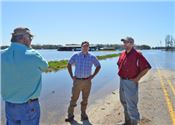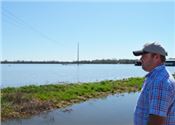|
Corn Hardest Hit By Flooding In Louisiana
BATON ROUGE, LA.
Louisiana’s recently planted corn crop appears to be the biggest agricultural casualty from recent flooding.
Dan Fromme, LSU AgCenter corn specialist, said corn farmers had planted roughly 30,000 acres in an eight-parish area of north Louisiana, or about 8 percent of the state’s total corn acreage in 2014.
Corn seed and seedlings will suffer from being flooded because of the lack of oxygen in the water-logged soil, he said.
Whether fields will have to be replanted is uncertain, according to Fromme. “You really won’t be certain for four to five days after the water subsides.”
He said replanting could cost roughly $140 an acre for seed, and $100 for fertilizer, in addition to fuel.
“And it will be hard getting seed to replant,” Fromme added.
Richard Letlow, LSU AgCenter county agent in Ouachita Parish, said 15-20 percent of the corn crop in Ouachita and Morehouse parishes had been planted. He said excessive moisture will complicate corn planting. “It is early in the planting window. However, wet conditions will push all corn planting toward the back end of this planting period.”
Keith Collins, LSU AgCenter in Richland Parish, estimated that 20,000 to 30,000 acres of unplanted corn acreage is underwater in his area. “It’s going to delay planting. If we could stay dry with no more rain, we may not see much of an impact. But if we get more rain, which is forecasted later this week, it could cause a delay.
He said 10-15 percent of corn acreage there has been planted. “There will be a tremendous amount of replant because it stayed underwater too long,” Collins said.
If the wet ground keeps farmers out of the fields after mid-April, corn farmers will have to turn to other options, such as soybeans.
Jason Holmes, LSU AgCenter county agent in Union Parish, said packets of information from the LSU AgCenter are being distributed to help homeowners cope with flood-damaged homes.
Pastureland will be affected by flooding.
“The biggest concern I have is for annual ryegrass pastures,” said LSU AgCenter forage specialist Ed Twidwell. “These pastures haven't been growing all that well this winter because of the excessive moisture received, so the areas that received a lot of rain will only make this problem worse.”
He said annual ryegrass can probably survive under flooded conditions for about 48 hours, but longer periods of flooding will kill ryegrass plants from the lack of oxygen.
“Once the floodwaters recede, the warm-season grasses such as bermudagrass and bahiagrass should begin to grow in these pastures,” he said.
With temperatures in the 70s and 80s, warm-season grasses should begin to green up fairly quickly. “They can handle wet conditions much better than annual ryegrass.”
In southwest Louisiana, most of the water has drained from rice fields, but the heavy rainfall interrupted planting for many farmers.
Steve Linscombe, director of the LSU AgCenter H. Rouse Caffey Rice Research Station near Crowley, said rice farmers who planned to drill-seed their crop are waiting for the soil to dry, but he said many had already started planting. “I’d say we probably have 30 percent planted in south Louisiana.”
Kurt Guidry, LSU AgCenter economist, said the state’s wheat crop has dwindled to only 50,000 acres, and not much of it was flooded.
Guidry said if corn farmers have to replant 18,000 acres of the 30,000 planted, the cost would exceed $2.5 million.
He said he has gotten reports of several hundred head of cattle lost from the floods. The lost grazing from flooded pastures will cost cattle operations also, he said.
Ryon Walker, LSU AgCenter cattle researcher at the Hill Farm Research Station, said flooding caused infrastructure damage in parts of northwest Louisiana. Fences, barns and roads have been affected, he said. “Hay that was flooded will not be any good.”
Several LSU AgCenter agents are helping to move cattle to higher ground.
“What rain has fallen north of us will affect us in the coming week or so,” Walker said. ∆

LSU AgCenter County Agent Richard Letlow, at left, talks with farmer
Chris Johnson, center, and Blair Sherman of Sanders Chemical Co. at Johnson’s farm in east Ouachita Parish.
Photos by Tammi Arender

Farmer Chris Johnson of Ouachita Parish looks out over the flood
500 acres of corn he planted recently. LSU AgCenter experts estimate
roughly 30,000 acres of corn has been flooded in Louisiana.
|
|